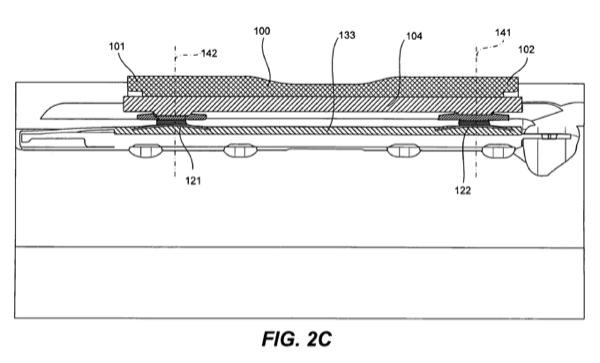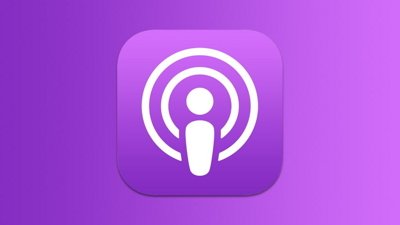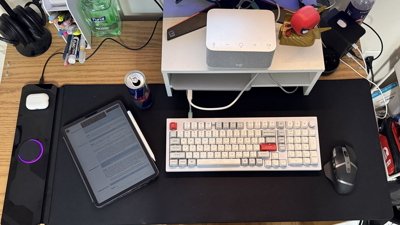The iPhone maker dropped a physical push button patent and 15 claims regarding plug-in detection and multitouch patents in an attempt to streamline its ongoing U.S. International Trade Commission dispute against Samsung, reports FOSS Patent's Florian Mueller.
Due to the ITC's strict timeline requirements, it is not uncommon for complainants to drop certain claims or entire patent assertions so that a favorable ruling can be reached.
Apple dropped U.S. Patent No. 7,863,533 for a "cantilevered push button having multiple contacts and fulcrums," and is most likely in response to Samsung's claim construction win regarding the IP. The IP is implemented in Apple devices as the volume rocker found on the iPhone, iPad and iPod touch among others.
Claim construction is an important step in patent litigation where the meaning of the asserted patent is interpreted by the court. Last week, Apple won favorable claim construction rulings on four of five asserted patents, though Samsung was successful in arguing against the '533 patent.
Apple's '533 push button patent. | Source: USPTO
In addition to the push button patent, Apple dropped claims 1-3, 11, 12, 15, 16, and 21-27 of U.S. Patent No. 7,789,697 on "plug detection mechanisms," and claim 3 of U.S. Patent No. 7,479,949 which describes a "[t]ouch screen device, method, and graphical user interface for determining commands by applying heuristics."
Mueller feels that Apple's decision to withdraw the 15 claims from the '697 and '949 patents was likely not related to claim construction, and was instead intended to bolster Apple's position against Samsung's non-infringement arguments.
The case may see more "streamlining" on Apple's part moving forward, some of which could happen with the upcoming evidentiary hearing, which will take place between May 31 and on June 6, 2012.
 AppleInsider Staff
AppleInsider Staff


 Malcolm Owen
Malcolm Owen
 Amber Neely
Amber Neely
 William Gallagher
William Gallagher



 Oliver Haslam
Oliver Haslam
 Thomas Sibilly
Thomas Sibilly


-m.jpg)






4 Comments
Wait, there weren't volume rockers on phones earlier than the iPhone? Or Apple's implementation was unique at the time?
I have a volume rocker on my phone. I've never actually used it because it does completely the wrong thing at all times, but it's there.
Wait, there weren't volume rockers on phones earlier than the iPhone? Or Apple's implementation was unique at the time?
I have a volume rocker on my phone. I've never actually used it because it does completely the wrong thing at all times, but it's there.
No silly. Apple patented the volume rocker years before the cell phone was invented. They invented it right after they invented the touch screen device and just before they stumbled upon their greatest invention....the rectangle.
Wait, there weren't volume rockers on phones earlier than the iPhone? Or Apple's implementation was unique at the time?
I have a volume rocker on my phone. I've never actually used it because it does completely the wrong thing at all times, but it's there.
Apparently, the differentiating feature of Apple's implementation, is that they didn't use a central point about which the two ends of the rocker pivoted. With regular rocker switches, one end of the rocker indents out slightly as the other end of the rocker is pushed in.
Apple's patent claimed to have innovated by using two structural junctions, one at either end of a rigid (non-bending) rocker switch, instead of a central pivot point. This way, pushing in one end of the rocker would have minimal to no impact on the position of the other end of the rocker, and hypothetically both ends of the rocker could be pushed in simultaneously, for example to denote "special" commands.
Now, I know that Samsung has rocker switches with similar behaviour - the ability to simultaneously depress both ends of a rocker switch, and the ability to depress one end of a rocker switch without causing the other end of the switch to stick out. Perhaps they were likely to successfully argue that Apple's patent didn't necessarily cover every possible method of assembling buttons which have these properties, and that Samsung's solution was arrived at by a different method.
No silly.
Come off it.
Apparently, the differentiating feature of Apple's implementation, is that they didn't use a central point about which the two ends of the rocker pivoted. With regular rocker switches, one end of the rocker indents out slightly as the other end of the rocker is pushed in.
Thanks for the answer.
My? phone does that. And I'm pretty sure the one I had before this one did it, too. I'd take my current one apart to be sure, but? it's my current one.